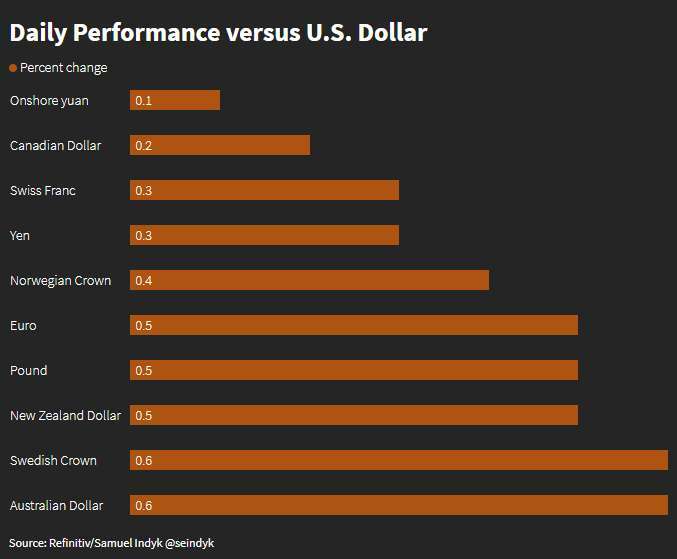
By Herbert Lash and Samuel Indyk
NEW YORK/LONDON (Reuters) – The dollar fell against most major currencies on Tuesday after better-than-forecast growth data from China, while strong pay figures from Britain supported the pound.
China’s gross domestic product (GDP) grew 4.5% year on year in the first three months of the year, data showed, beating analyst forecasts for a 4% expansion after the end of COVID-19 restrictions lifted the world’s second-largest economy.
Separate data on March activity in China also showed retail sales growth quickened to 10.6%, beating expectations and hitting a near two-year high, while factory output growth also sped up but was just below expectations.
“The view on the dollar getting a bit weaker from here against the majors is predicated on a strong China,” said Thierry Wizman, Macquarie global FX & rates strategist in New York. “When you have the rest of the world doing well or better than U.S. in terms of activity … that’s usually bad for the dollar.”
Also driving dollar weakness is the likelihood disinflation already is occurring in the United States, a reason the Federal Reserve is going to pause hiking interest rates, Wizman said.
“There’s a good chance that the euro and Sterling continue to do well,” he said. “It starts with the disinflation story in the U.S., which is something that people are not really latching on to.”
The euro rose 0.38% to $1.0968 after two consecutive daily declines of more than 0.5%, while the dollar index, a measure of the greenback against six major currencies, slid 0.362%. The index rose over 1% in the last two trading sessions.
China’s offshore yuan rose 0.02% to $6.8824 per dollar.
Britain’s pound jumped despite an unexpected rise in the unemployment rate in the three months to February as pay growth stayed higher than forecast, which could prompt the Bank of England to hike its interest rate again in May.
“The surprise this year has been how strong the euro has been and Sterling, especially, given that we were coming out of the second half of last year with a multitude of crises in Europe,” Wizman said.
Sterling was last trading at $1.2427, up 0.43% on the day.
Futures traders are pricing in an 83.4% chance of the Fed raising rates by 25 basis points at its next meeting in May, with traders still expecting rate cuts toward the end of the year.
Jim Caron, co-chief investment officer of the Global Risk Balanced Team at Morgan Stanley Investment Management, said after a hike in May the Fed will keep rates in the 5%-5.25% range the entire year to ensure inflation remains under control.
“What keeps the Fed up at night is the fear that inflation becomes unanchored” and doesn’t remain lower near the U.S. central bank’s 2% target, Caron said. “If it starts to percolate back up again, and it becomes unanchored, then that’s a bigger problem.”
The U.S. central bank should continue raising rates on the back of recent data showing inflation remains persistent while the broader economy seems poised to continue growing, even if slowly, St. Louis Fed President James Bullard told Reuters.

Rates and inflation https://www.reuters.com/graphics/USA-FED/INFLATION/gkvlgnaywpb/chart.png
“The dollar can remain sensitive to the strength, or not, of the economic data as the Fed likely nears the end of their tightening cycle,” said Kristina Clifton, an economist at Commonwealth Bank of Australia (CBA).
The Australian dollar rose 0.39% versus the greenback to $0.673 after Reserve Bank of Australia (RBA) minutes showed the central bank considered an 11th consecutive rate hike in April before deciding to pause.
The RBA, however, said it was ready to tighten further if inflation and demand failed to cool.
The yen strengthened 0.32% to 134.05 per dollar.
The Mexican peso lost 0.21% versus the dollar at 18.05 while the Canadian dollar fell 0.01% versus the greenback to 1.34 per dollar.

Dollar 18 aPRIL https://fingfx.thomsonreuters.com/gfx/mkt/gdpzqngxzvw/Pasted%20image%201681815523393.png
(Reporting by Herbert Lash, additional reporting by Samuel Indyk in London and Ankur Banerjee in Singapore; Editing by Marguerita Choy, Mark Potter and Jonathan Oatis)


